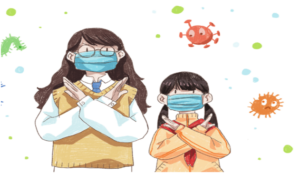
01 Before the opening of primary and secondary schools
02After the opening of primary and secondary schools,
03 Emergency Treatment of Suspected Infection Symptoms
01 Before the opening of primary and secondary schools
- The school has a daily grasp of the health status of teaching staff and students, implements the “daily report” and “zero report” systems, and reports to the competent department.
- The School carries out knowledge and skills training on prevention and control system, personal protection and disinfection for all teaching staff.
- Thoroughly clean the school before the start of school, carry out preventive disinfection treatment on the surface of the object, and open windows and ventilate the classroom.
- All teaching staff and students who go out or abroad shall be isolated at home for 14 days before returning to school after returning to their place of residence.
- Do a good job in the storage of hand sanitizer, hand disinfectant, mask, gloves, disinfectant and other prevention and control materials.
Suggestion: Reserve a certain number of disposable working caps, isolation clothing and protective clothing, protective screens or goggles, working shoes or rubber boots, waterproof boot covers, waterproof aprons, etc. for use in contact cases and environmental disinfection.
- Set up a (temporary) isolation room with relatively independent location to temporarily isolate personnel in case of fever and other symptoms.
- Formulate an emergency plan for epidemic prevention and control, with a clear system, responsibilities to people, and training and drills. The principal is the first responsible person for epidemic prevention and control in this unit.
After the opening of primary and secondary schools,
- Grasp the health status of teaching staff and students every day, strengthen the morning and afternoon examinations of students and teaching staff, implement the “daily report” and “zero report” systems, and report to the competent department.
- Keep the disinfectant properly and mark it clearly to avoid accidental ingestion or burns.When disinfection treatment is carried out, the operators shall take effective protective measuresStrengthen ventilation in all kinds of living, studying and working places (such as classrooms, dormitories, libraries, student laboratories, sports venues, restaurants, teachers’ offices, toilets, etc.). Ventilation shall not be less than 3 times a day for not less than 30 minutes each time. Try to open windows for ventilation during recess, or mechanical ventilation can be used. If air conditioning is used, the air supply safety of the air conditioning system shall be ensured, sufficient fresh air input shall be ensured, and all exhaust air shall be directly discharged to the outside.
-
- Strengthen the surface cleaning and disinfection of objects. The environment in classrooms, dormitories, libraries, restaurants and other places shall be kept clean and tidy, and shall be disinfected and recorded regularly every day. For high-frequency contact surfaces such as door handles, faucets, stair handrails, dormitory bed fences, indoor fitness equipment, etc., chlorine-containing disinfectants with available chlorine 250 ~ 500mg/L can be used for wiping, or disinfectant wipe can be used for wiping.
- Strengthen the cleaning and disinfection of food (drinking) utensils. Food (drinking) utensils should be disinfected one by one. It is recommended that students bring their own tableware. Remove residues from food (drinking) utensils, after cleaning, boil or circulate steam for disinfection for 15 minutes; Or use thermal disinfection cabinet and other disinfection methods; Or soak in chlorine-containing disinfectant with available chlorine 250mg/L for 30 minutes, and wash away the residual disinfectant after disinfection.
- Sanitary ware can be soaked or wiped with chlorine-containing disinfectant with available chlorine 500mg/L for disinfection. After 30 minutes of action, rinse with clear water.
- Ensure the normal operation of school hand washing facilities. Primary and secondary schools have a hand washing basin or 0.6 m long washbasin for every 40 ~ 45 people, and are equipped with hand sanitizer, soap, etc., quick-drying hand disinfectant, and inductive hand disinfection facilities when conditions permit.
- Strengthen the classified management of garbage, collect and remove it in time, and clean the garbage container. Chlorine-containing disinfectant with available chlorine 500mg/L can be used to disinfect it regularly.
- Teachers are advised to wear medical masks when teaching.
- Strictly implement hand hygiene measures for teaching staff and students. Wash hands before meals, before defecation, after contacting garbage, after returning from going out, after using public goods such as sports equipment and school computers, after contacting animals, before touching “susceptible” parts such as eyes, and after contacting contaminated goods. Hand sanitizer or soap should be used when washing hands. Wash hands thoroughly according to the correct washing method under flowing water. You can also rub hands with quick-drying hand disinfectant.
- Strengthen the management of absence due to illness. Make records of absenteeism, early departure and leave, and timely follow up and report to teaching staff and students who are absent from work due to illness.
- Large-scale collective events should not be organized.
(1) No large number of on-site collective activities should be held.
(2) Strictly reduce the scale, quantity and frequency of various meetings.
(3) All cross-department, cross-school and cross-regional personnel gathering activities will be suspended.
(4) Strictly control teachers, students and employees to participate in exchange and learning activities overseas and in other provinces and cities.
20 to carry out personal protection and disinfection and other prevention and control knowledge publicity and guidance for teaching staff, students and parents. Demonstrate students’ correct hand washing methods, cultivate students to form good hygiene habits, and cover their nose and mouth with paper towels and sleeves when coughing or sneezing.
03 Emergency Treatment of Suspected Infection Symptoms
- Teachers and staff who have fever, dry cough, fatigue, nasal obstruction, runny nose, sore throat, diarrhea and other symptoms shall immediately report to the person in charge of the school and go to the designated hospital for medical treatment in a timely manner according to regulations. Try to avoid taking public transportation such as public transportation and subway, and wear surgical mask (or other higher-level masks) on the way to and within the hospital.
- If students have fever, dry cough, fatigue, nasal obstruction, runny nose, sore throat, diarrhea and other symptoms, they should timely feedback to the school and take corresponding measures.
- If there are suspected cases of novel coronavirus pneumonia among teaching staff or students, they shall immediately report to the disease prevention and control department under their jurisdiction, and cooperate with relevant departments to do a good job in the management of close contacts.
- Provide risk notification to general contacts living and studying together, and seek medical treatment in time when suspected symptoms such as fever and dry cough occur.
- Special personnel are responsible for contacting the parents of teaching staff or students who are subject to isolation and mastering their health status.
Overcome difficulties together and protect the health of teachers and students together!
Source: Jiangsu Center for Disease Control and Prevention
